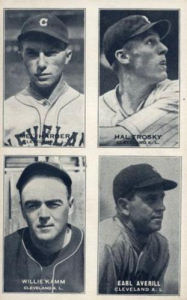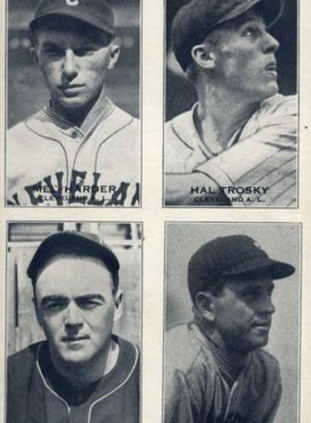May 16, 1939: A’s fall in first night game at Shibe Park
 Philadelphia’s Shibe Park, opened in 1909, ushered in the modern era of ballpark construction with the first steel-and-concrete stadium in major-league baseball. It was fitting that the elegant ballpark with a French Renaissance-style façade would host the first night game in the American League, on May 16, 1939.
Philadelphia’s Shibe Park, opened in 1909, ushered in the modern era of ballpark construction with the first steel-and-concrete stadium in major-league baseball. It was fitting that the elegant ballpark with a French Renaissance-style façade would host the first night game in the American League, on May 16, 1939.
The first night game in the majors was played on May 24, 1935, when the Cincinnati Reds defeated the Philadelphia Phillies 2-1 at Crosley Field.1
The A’s were the third major-league team to play under the lights, following National League cities Cincinnati and then Brooklyn in 1938 at Ebbets Field. The Phillies, who shared Shibe Park with the A’s, followed on June 1, 1939.2
The lighting system installed at Shibe Park was said to have enough illumination to light more than 2,000 homes. Huge light standards were erected on the 20th Street side of the park and on top of the left-field stands. In all, 27,080 50-watt lamps were deployed to light the field.3
The significance of the game attracted the attendance of many dignitaries from the baseball community, including American League President Will Harridge, Cleveland Indians owner Alva Bradley, Washington Senators President
Clark Griffith, and St. Louis Browns President Don Barnes. Commissioner Kenesaw Landis was scheduled to attend the historic game, but canceled because of urgent business in Chicago. The game’s pregame festivities included two band concerts.4
The game was witnessed by 15,109 shivering fans. Higher attendance was expected, but the low temperature changed some fans’ minds. When the game started at 8:55 P.M., the temperature was 54 degrees Fahrenheit and it dropped into the mid-40s by the end of the game at 11:36. The size of the crowd may also have been reduced by an overoptimistic newspaper story earlier in the day predicting that it would be difficult to gain admission because of an expected capacity crowd.5
Coming into the game, the Indians had won six of their last seven games. They were in fourth place in the American League, four games behind the New York Yankees, while the A’s were in last place, in the middle of a stretch of nine consecutive seasons with a seventh- or eighth-place finish. Owner-manager Connie Mack was in his 39th season as the A’s skipper.
Indians manager Ossie Vitt started left-hander Al Milnar, who had posted complete-game wins in his first two starts of the season. Mack countered with Lynn Nelson, who was making his first start of the season after four relief appearances.
Cleveland outfielder Roy Weatherly, who was hitting .414 coming into game, was the first American League player to bat in a game played under the lights. He flied out to center field.
The A’s put the first run on the scoreboard in the bottom of the first. After a walk to Joe Gantenbein, a single by Sam Chapman, and a walk to Bob Johnson, Nick Etten drove in Gantenbein with a force out at second base.
The A’s scored another run on Frankie Hayes’ leadoff home run into the upper deck in the bottom of the second.
The Indians scored in the fourth on team captain Hal Trosky’s solo home run. The 26-year-old Trosky suffered from severe headaches that season which limited him to less than 150 games for the first time since he had become the Indians’ regular first baseman in 1934.
Neither team threatened to score again until the Athletics’ seventh inning. Nelson led off by reaching base on second baseman Jim Shilling’s error but was picked off first by catcher Rollie Hemsley. Dee Miles then singled and went to second on Gantenbein’s walk. With Chapman batting, Milnar attempted to pick off Miles at second, but the ball was mishandled by Shilling. Runners Miles and Gantenbein both advanced on the error. Chapman’s fly ball to right scored Miles and made the score 3-1. Milnar got out of the inning without yielding another run.
The Indians got even in the top of the eighth. Oscar Grimes walked with one out. Nelson struck out Earl Averill, pinch-hitting for Milnar, but he gave up a double to Weatherly, scoring Grimes. Batting for Hemsley, Odell Hale singled in Weatherly to tie the score, 3-3. After a single by Trosky, Roy Parmelee relieved Nelson and retired Jeff Heath.
Philadelphia had an opportunity to break the tie in the home half of the inning. With Johnny Humphries pitching, Billy Nagel began the inning with a double. But Humphries retired the next three batters to squelch the A’s go-ahead attempt.
The Indians got a runner to third base in the top of the ninth with one out, but couldn’t push across a run against Parmelee. When the Athletics failed to score in the home half, the game went into extra innings.
Parmelee fell apart in the 10th. He gave up three walks, then Heath doubled to score Frankie Pytlak and Weatherly. Bruce Campbell’s fielder’s-choice groundball to second scored Trosky. Ken Keltner followed with a single that plated Heath, and Campbell scored on Shilling’s force-play grounder to short. Parmelee wound up yielding five earned runs on only two hits. Reliever Johnnie Humphreys blanked the Athletics in the bottom of the inning and the Indians were 8-3 winners.
Milnar struck out six before yielding to Humphries, who pitched three efficient innings for his first win of the season. Parmelee suffered his fifth straight loss. Trosky and Heath paced the Indians with two hits apiece.
Cleveland manager Vitt used his reserves extensively throughout the game. By its end, no position players were left on the bench.
After the game American League President Harridge said, “The lights at Shibe Park are wonderful, and I could see details of the game as well as I could if it had been daylight. I can’t speak for the league owners as to whether all will go in for lights next year, that’s entirely up to them, but there’s lots to be said for night baseball. Certainly, I could pick no flaws in this game.”6
The major leagues had been relatively slow to adopt nighttime baseball. The minors had begun playing under the lights almost 10 years earlier, and virtually every minor-league ballpark had installed lights by the time of Shibe’s inaugural night game. Night baseball was considered the salvation of minor-league baseball.
Larry MacPhail, president of the Brooklyn Dodgers, persuaded Connie Mack to go against the league’s owners who opposed night games and install lights at Shibe Park. The Dodgers had attributed their financial turnaround the prior year to night games.7
Not yet convinced that night games would be popular among the fans, the A’s scheduled only six more night games in Shibe Park in 1939, once for each of the other American League teams. They were all played on weekdays. The next A’s game under the lights was played on May 24 against the White Sox in front of a paltry crowd of 1,874. However, their game against the first-place New York Yankees on June 26 drew a near-capacity crowd of 33,074 fans. The Phillies also played eight night games at Shibe Park. American League teams Chicago and Cleveland later played night games in 1939 as well.
Yankees President Ed Barrow still opposed night games at Yankee Stadium. Barrow said, “Just so long as I have anything to do with the Yankees, there will be no night games in our stadium.” Nevertheless, he agreed to play in other teams’ lighted ballparks, since the Yankees helped pack stadiums in opposing cities.8 Indeed, Yankee Stadium did not host its first night game until 1946, after Barrow left his job as president.
Of course, major-league teams’ apprehensions over night baseball eventually dissipated. Yet it wasn’t until August 9, 1988, that the last of the 16 original franchises played its first night game, when the Chicago Cubs played the New York Mets under the lights at Wrigley Field.
SOURCES
In addition to the sources cited in the Notes, the author consulted:
baseball-reference.com/boxes/PHA/PHA193905160.shtml
retrosheet.org/boxesetc/1939/B05160PHA1939.htm
McLinn, Stoney. “Connie Mack, Linking Birth of American with Present, First to Light Up in Loop,” The Sporting News, May 25, 1939: 2.
NOTES
1 Norm King. “Reds Fans See the Light(s),” Cincinnati’s Crosley Field: A Gem in the Queen City (Phoenix: Society for American Baseball Research, 2018), 95.
2 baseball-almanac.com/firsts/first10.shtml. Accessed January 11, 2019.
3 James Isaminger, “Nelson Will Hurl Opening Night Tilt Against Indians,” Philadelphia Inquirer, May 16, 1939: 25.
4 Isaminger, “Nelson Will Hurl Opening Night Tilt Against Indians.”
5 “Sidelights on the A.L.’s First Arc-Light Game,” The Sporting News, May 25, 1939: 4.
6 “Sidelights on the A.L.’s First Arc-Light Game.”
7 James Isaminger, “Cleveland Rallies in Tenth to Beat A’s in Night Game,” Philadelphia Inquirer, May 17, 1939: 25.
8 “Yankees Yield on Night Baseball to Aid Other Clubs,” The Sporting News, May 25, 1939: 1.
Additional Stats
Cleveland Indians 8
Philadelphia Athletics 3
10 innings
Shibe Park
Philadelphia, PA
Box Score + PBP:
Corrections? Additions?
If you can help us improve this game story, contact us.


